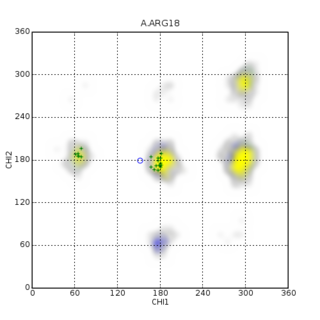Related Research Articles

Solid-state NMR (ssNMR) spectroscopy is a type of nuclear magnetic resonance (NMR) spectroscopy, characterized by the presence of anisotropic interactions. Compared to the more common solution NMR spectroscopy, ssNMR usually requires additional hardware for high-power radio-frequency irradiation and magic-angle spinning.
Nuclear magnetic resonance spectroscopy of proteins is a field of structural biology in which NMR spectroscopy is used to obtain information about the structure and dynamics of proteins, and also nucleic acids, and their complexes. The field was pioneered by Richard R. Ernst and Kurt Wüthrich at the ETH, and by Ad Bax, Marius Clore, Angela Gronenborn at the NIH, and Gerhard Wagner at Harvard University, among others. Structure determination by NMR spectroscopy usually consists of several phases, each using a separate set of highly specialized techniques. The sample is prepared, measurements are made, interpretive approaches are applied, and a structure is calculated and validated.

The residual dipolar coupling between two spins in a molecule occurs if the molecules in solution exhibit a partial alignment leading to an incomplete averaging of spatially anisotropic dipolar couplings.
Residual chemical shift anisotropy (RCSA) is the difference between the chemical shift anisotropy (CSA) of aligned and non-aligned molecules. It is normally three orders of magnitude smaller than the static CSA, with values on the order of parts-per-billion (ppb). RCSA is useful for structural determination and it is among the new developments in NMR spectroscopy.
Adriaan "Ad" Bax is a Dutch-American molecular biophysicist. He was born in the Netherlands and is the Chief of the Section on Biophysical NMR Spectroscopy at the National Institutes of Health. He is known for his work on the methodology of biomolecular NMR spectroscopy.
Bruce Randall Donald is an American computer scientist and computational biologist. He is the James B. Duke Professor of Computer Science and Biochemistry at Duke University. He has made numerous contributions to several fields in Computer Science such as robotics, Microelectromechanical Systems (MEMS), Geometric & physical algorithms and computational geometry; as well as in areas of Structural Molecular Biology & Biochemistry such as Protein design, Protein Structure Determination and Computational Chemistry.

In biomolecular structure, CING stands for the Common Interface for NMR structure Generation and is known for structure and NMR data validation.
Nuclear magnetic resonance crystallography is a method which utilizes primarily NMR spectroscopy to determine the structure of solid materials on the atomic scale. Thus, solid-state NMR spectroscopy would be used primarily, possibly supplemented by quantum chemistry calculations, powder diffraction etc. If suitable crystals can be grown, any crystallographic method would generally be preferred to determine the crystal structure comprising in case of organic compounds the molecular structures and molecular packing. The main interest in NMR crystallography is in microcrystalline materials which are amenable to this method but not to X-ray, neutron and electron diffraction. This is largely because interactions of comparably short range are measured in NMR crystallography.

WeNMR is a worldwide e-Infrastructure for NMR spectroscopy and structural biology. It is the largest virtual Organization in the life sciences and is supported by EGI.

Macromolecular structure validation is the process of evaluating reliability for 3-dimensional atomic models of large biological molecules such as proteins and nucleic acids. These models, which provide 3D coordinates for each atom in the molecule, come from structural biology experiments such as x-ray crystallography or nuclear magnetic resonance (NMR). The validation has three aspects: 1) checking on the validity of the thousands to millions of measurements in the experiment; 2) checking how consistent the atomic model is with those experimental data; and 3) checking consistency of the model with known physical and chemical properties.

GeNMR method is the first fully automated template-based method of protein structure determination that utilizes both NMR chemical shifts and NOE -based distance restraints.

CS23D is a web server to generate 3D structural models from NMR chemical shifts. CS23D combines maximal fragment assembly with chemical shift threading, de novo structure generation, chemical shift-based torsion angle prediction, and chemical shift refinement. CS23D makes use of RefDB and ShiftX.

Conformational ensembles, also known as structural ensembles are experimentally constrained computational models describing the structure of intrinsically unstructured proteins. Such proteins are flexible in nature, lacking a stable tertiary structure, and therefore cannot be described with a single structural representation. The techniques of ensemble calculation are relatively new on the field of structural biology, and are still facing certain limitations that need to be addressed before it will become comparable to classical structural description methods such as biological macromolecular crystallography.

The chemical shift index or CSI is a widely employed technique in protein nuclear magnetic resonance spectroscopy that can be used to display and identify the location as well as the type of protein secondary structure found in proteins using only backbone chemical shift data The technique was invented by Dr. David Wishart in 1992 for analyzing 1Hα chemical shifts and then later extended by him in 1994 to incorporate 13C backbone shifts. The original CSI method makes use of the fact that 1Hα chemical shifts of amino acid residues in helices tends to be shifted upfield relative to their random coil values and downfield in beta strands. Similar kinds of upfield/downfiled trends are also detectable in backbone 13C chemical shifts.
Protein chemical shift prediction is a branch of biomolecular nuclear magnetic resonance spectroscopy that aims to accurately calculate protein chemical shifts from protein coordinates. Protein chemical shift prediction was first attempted in the late 1960s using semi-empirical methods applied to protein structures solved by X-ray crystallography. Since that time protein chemical shift prediction has evolved to employ much more sophisticated approaches including quantum mechanics, machine learning and empirically derived chemical shift hypersurfaces. The most recently developed methods exhibit remarkable precision and accuracy.
Nuclear magnetic resonance chemical shift re-referencing is a chemical analysis method for chemical shift referencing in biomolecular nuclear magnetic resonance (NMR). It has been estimated that up to 20% of 13C and up to 35% of 15N shift assignments are improperly referenced. Given that the structural and dynamic information contained within chemical shifts is often quite subtle, it is critical that protein chemical shifts be properly referenced so that these subtle differences can be detected. Fundamentally, the problem with chemical shift referencing comes from the fact that chemical shifts are relative frequency measurements rather than absolute frequency measurements. Because of the historic problems with chemical shift referencing, chemical shifts are perhaps the most precisely measurable but the least accurately measured parameters in all of NMR spectroscopy.
Protein chemical shift re-referencing is a post-assignment process of adjusting the assigned NMR chemical shifts to match IUPAC and BMRB recommended standards in protein chemical shift referencing. In NMR chemical shifts are normally referenced to an internal standard that is dissolved in the NMR sample. These internal standards include tetramethylsilane (TMS), 4,4-dimethyl-4-silapentane-1-sulfonic acid (DSS) and trimethylsilyl propionate (TSP). For protein NMR spectroscopy the recommended standard is DSS, which is insensitive to pH variations. Furthermore, the DSS 1H signal may be used to indirectly reference 13C and 15N shifts using a simple ratio calculation [1]. Unfortunately, many biomolecular NMR spectroscopy labs use non-standard methods for determining the 1H, 13C or 15N “zero-point” chemical shift position. This lack of standardization makes it difficult to compare chemical shifts for the same protein between different laboratories. It also makes it difficult to use chemical shifts to properly identify or assign secondary structures or to improve their 3D structures via chemical shift refinement. Chemical shift re-referencing offers a means to correct these referencing errors and to standardize the reporting of protein chemical shifts across laboratories.

G. Marius Clore MAE, FRSC, FRS is a British-born, American molecular biophysicist and structural biologist. He was born in London, U.K. (1955) and is a dual US/U.K. Citizen. He is a Member of the National Academy of Sciences, a Fellow of the Royal Society, a NIH Distinguished Investigator, and the Chief of the Molecular and Structural Biophysics Section in the Laboratory of Chemical Physics of the National Institute of Diabetes and Digestive and Kidney Diseases at the U.S. National Institutes of Health. He is known for his foundational work in three-dimensional protein and nucleic acid structure determination by biomolecular NMR spectroscopy, for advancing experimental approaches to the study of large macromolecules and their complexes by NMR, and for developing NMR-based methods to study rare conformational states in protein-nucleic acid and protein-protein recognition. Clore's discovery of previously undetectable, functionally significant, rare transient states of macromolecules has yielded fundamental new insights into the mechanisms of important biological processes, and in particular the significance of weak interactions and the mechanisms whereby the opposing constraints of speed and specificity are optimized. Further, Clore's work opens up a new era of pharmacology and drug design as it is now possible to target structures and conformations that have been heretofore unseen.

Hartmut Oschkinat is a German structural biologist and professor for chemistry at the Free University of Berlin. His research focuses on the study of biological systems with solid-state nuclear magnetic resonance.

Mei Hong is a Chinese-American biophysical chemist and Professor of Chemistry at the Massachusetts Institute of Technology. She is known for her creative development and application of solid-state nuclear magnetic resonance (ssNMR) spectroscopy to elucidate the structures and mechanisms of membrane proteins, plant cell walls, and amyloid proteins. She has received a number of recognitions for her work, including the American Chemical Society Nakanishi Prize in 2021, Günther Laukien Prize in 2014, the Protein Society Young Investigator award in 2012, and the American Chemical Society’s Pure Chemistry award in 2003.
References
- ↑ Shen, Y; Lange, O; Delaglio, F; Rossi, P; Aramini, JM; Liu, G; Eletsky, A; Wu, Y; et al. (2008). "Consistent blind protein structure generation from NMR chemical shift data". Proceedings of the National Academy of Sciences of the United States of America. 105 (12): 4685–90. Bibcode:2008PNAS..105.4685S. doi: 10.1073/pnas.0800256105 . PMC 2290745 . PMID 18326625.
- ↑ Raman, S.; Lange, O. F.; Rossi, P.; Tyka, M.; Wang, X.; Aramini, J.; Liu, G.; Ramelot, T. A.; et al. (2010). "NMR Structure Determination for Larger Proteins Using Backbone-Only Data". Science. 327 (5968): 1014–8. Bibcode:2010Sci...327.1014R. doi:10.1126/science.1183649. PMC 2909653 . PMID 20133520.
- ↑ Lange, O. F.; Rossi, P.; Sgourakis, N. G.; Song, Y.; Lee, H.-W.; Aramini, J. M.; Ertekin, A.; Xiao, R.; et al. (2012). "Determination of solution structures of proteins up to 40 kDa using CS-Rosetta with sparse NMR data from deuterated samples". Proceedings of the National Academy of Sciences of the United States of America. 109 (27): 10873–8. Bibcode:2012PNAS..10910873L. doi: 10.1073/pnas.1203013109 . PMC 3390869 . PMID 22733734.
- ↑ Schmitz, C; Vernon, R; Otting, G; Baker, D; Huber, T (2012). "Protein structure determination from pseudocontact shifts using ROSETTA" (PDF). Journal of Molecular Biology. 416 (5): 668–77. doi:10.1016/j.jmb.2011.12.056. PMC 3638895 . PMID 22285518. Archived from the original (PDF) on 2012-07-12.
- ↑ Thompson, J M.; Sgourakis, N G.; Liu, G; Rossi, P; Tang, Y; Mills, J L.; Szyperski, T; Montelione, G T.; Baker, D (2012-06-19). "Accurate protein structure modeling using sparse NMR data and homologous structure information". Proceedings of the National Academy of Sciences. 109 (25): 9875–9880. Bibcode:2012PNAS..109.9875T. doi: 10.1073/pnas.1202485109 . ISSN 0027-8424. PMC 3382498 . PMID 22665781.
- ↑ Sgourakis, N G.; Lange, O F.; DiMaio, F; André, I; Fitzkee, N C.; Rossi, P; Montelione, G T.; Bax, A; Baker, D (2011-04-27). "Determination of the Structures of Symmetric Protein Oligomers from NMR Chemical Shifts and Residual Dipolar Couplings". Journal of the American Chemical Society. 133 (16): 6288–6298. doi:10.1021/ja111318m. ISSN 0002-7863. PMC 3080108 . PMID 21466200.
- ↑ Lange, O F. (2014-07-01). "Automatic NOESY assignment in CS-RASREC-Rosetta". Journal of Biomolecular NMR. 59 (3): 147–159. doi:10.1007/s10858-014-9833-3. ISSN 0925-2738. PMID 24831340. S2CID 28946271.
- ↑ Evangelidis, T; Nerli, S; Nováček, J; Brereton, A E.; Karplus, P. A; Dotas, R R.; Venditti, V; Sgourakis, N G.; Tripsianes, K (2018-01-26). "Automated NMR resonance assignments and structure determination using a minimal set of 4D spectra". Nature Communications. 9 (1): 384. Bibcode:2018NatCo...9..384E. doi:10.1038/s41467-017-02592-z. ISSN 2041-1723. PMC 5786013 . PMID 29374165.